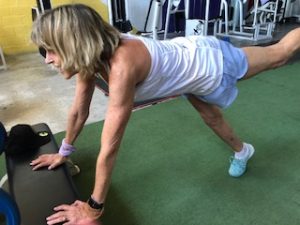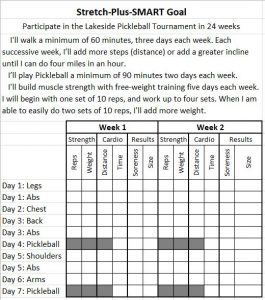 As an older person, do you have trouble motivating yourself to exercise? Everyone’s different, but here are a few tips on how to motivate, mold and manage your muscles, especially for seniors who want to keep fit.
As an older person, do you have trouble motivating yourself to exercise? Everyone’s different, but here are a few tips on how to motivate, mold and manage your muscles, especially for seniors who want to keep fit.
If you’re anything like me, motivation is half the battle. I’ve found that creating SMART stretch goals is helpful, but I see the best results when I:
- Focus on short-term goals
- See some type of results
- Hold myself accountable
Focus on Short-Term Goals
I’ve written about creating stretch-plus SMART goals, here, and most recently, here. A stretch goal is something you don’t really know if you could achieve. It’s big. The trick is to break it down into small, short-term goals.
For example, if you want to re-build your muscles after being sedentary, make it manageable by breaking it down into body parts:
Day 1: Legs and Abs
Day 2: Chest
Day 3: Back and Abs
Day 4: Rest day
Day 5: Shoulder and Abs
Day 6: Arms
Day 7: Rest day or stretching
This schedule is designed to get the three toughest days done when you’re fresh and to separate chest exercises from arms to allow joints to heal optimally. Set short-term goals for each body part. (Wondering about your fitness level? Check out these fitness level tests.)
See and Track Results
When you first start to mold and manage your muscle, soreness and some fatigue are normal. After a few weeks, your body adapts and you won’t be that sore after your workout. Eventually, you will see results. Track it all!
- Chart your soreness on a scale, with 5 being the highest level of discomfort.
- Take measurements of your arms, thighs, calves, bust/chest, waist, and hips (before and after, but give it some time).
- Track the amounts of weights and level of resistance you are using, as well as number of reps, speed, distance, etc.
Consider creating a spreadsheet, clearly stating your Stretch-plus-SMART goal, your plan, and your activities.
For example, let’s say you want to enter a pickleball tournament in 24 weeks, but you need to build endurance and totally body strength. Your tracking spreadsheet might look something like this:

As you build strength, your numbers should change, and you should see results.
Accountability
Sure, some days are easier than others, but invariably, I hear myself make excuses to not go to the gym. That’s why I’ve got built in “excuse-busters” in place. What works for me is an appointment with my trainer—I don’t want to keep her waiting.
If a personal trainer doesn’t sound like your thing, consider asking someone to be your accountability partner, or exercise buddy.
According to Penn State, accountability partnerships are hugely beneficial and can help with reaching health goals and even weight loss.
A good accountability partner should be willing and able to offer you encouragement and support in alignment with your fitness goals. Of course, you may find that you need more than one person to help you. Communicate your plans to them (phone, email, text) and let them know what you are determined to do. If you create your own tracking spreadsheet, share it with them.
Now then, go get ’em!

Recent Comments